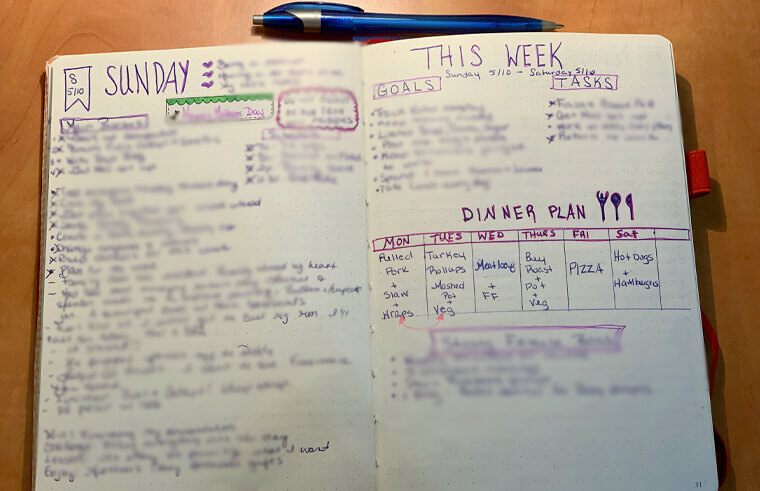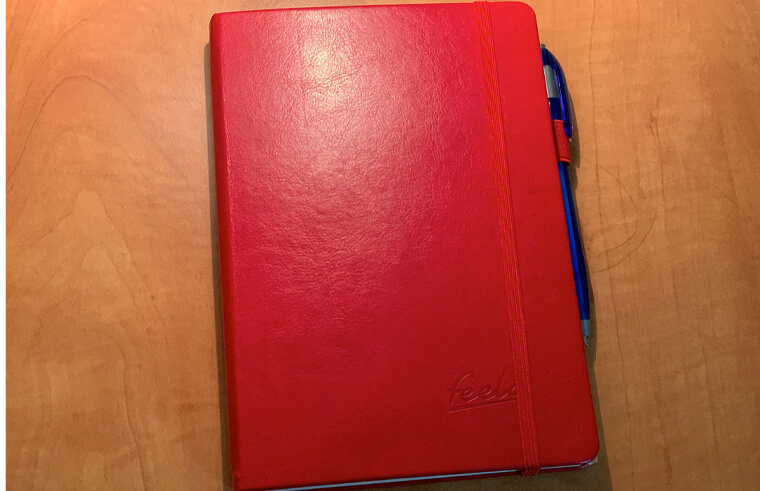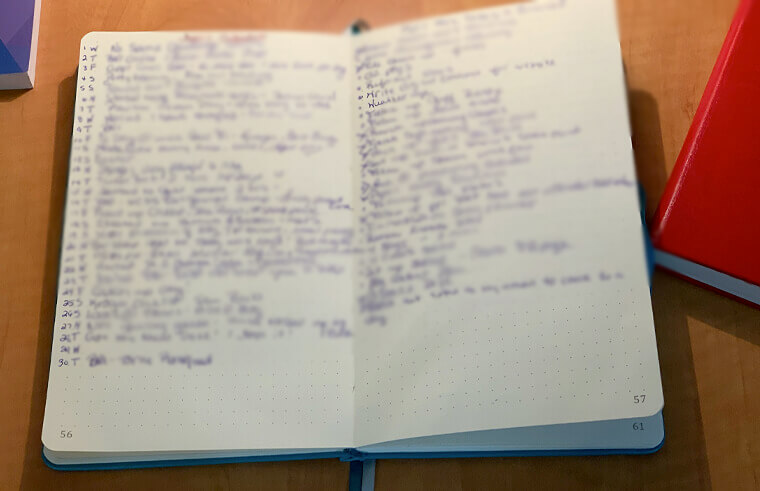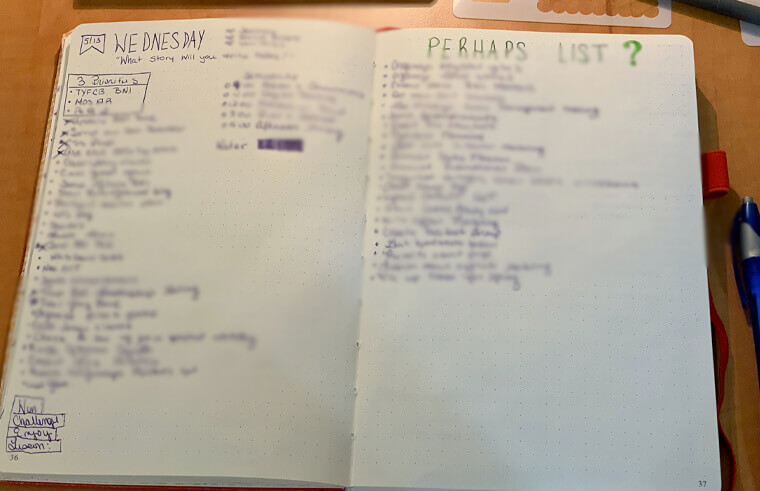Back to life, back to reality. Things are starting to open up all around us but we are still dealing with the trauma caused by a pandemic. As people, we have been accustomed to saying things are okay with a smile on our face, even when things are obviously not okay. Right now some are nearing burn out trying to balance life, work, family, and a global crisis. How do you juggle all of this and still maintain your sanity? I’m here to share some ways that you can successfully balance work and life by creating and using a bullet journal.
Get Organized with a Bullet Journal
How many times have you written things down but when it comes time to reference that thought, you can’t find where you put it? Emails, notes on your phone, post its, voice memos, and the list goes on. This was my reality until I discovered Bullet Journaling. This system has absolutely changed my life because I put all things in one place. By doing this it cuts down on the recurring thoughts of outstanding tasks, ideas, and lists giving your mind a much-deserved break.
What is a Bullet Journal?
A bullet journal is a cross between a planner, journal, tracker, and more. The best part is there are no fancy kits or materials that you need to buy to get started. All you really need is a notebook and a pen or pencil. If you really want to get fancy I recommend a journal with dotted and numbered pages that has an index in the front like this one. I personally also like the journals with ribbons and an elastic loop to hold your pen.
How To Structure A Bullet Journal
A bullet journal typically has a future log, daily log, and monthly spreads. After the index section of your bullet journal, I suggest creating a future log for the next 6 months. This will be the place that you jot down all future events or things to remember that don’t need to be on your busy mind right now. Write them down here, set it and forget it.
The Daily Log

Most of your Bullet Journal will be filled with your daily logs. This is the place that you write down every and anything that comes to your mind, that you’d like to remember. This log can include things like tasks, events, thoughts, ideas, notes and basically anything else that you can think of. If your mind is always busy like mine, you’re probably thinking that pages tend to fill up quickly.
Rapid Logging

If you bullet journal most likely you are using a system called “rapid logging”. This is a short form way of keeping track of things in bulleted lists. Your thoughts are summarized so that you know what you are referencing, time is saved by not writing out every single detail. As an example, I could write something like this. “Call Florist Re: Gift Mom” opposed to writing “call the florist to order my mom a bouquet of roses for her birthday on June 4th”. Same premise, way fewer words. Before we start rapid logging lets classify our thoughts.
Bullet Journal Key
Keep your bullet journal neat by classifying your thoughts with symbols. My symbols are pretty basic. I suggest adding a key that lists your personal symbols after the index. PRO TIP: Make sure not to add too many symbols because it can cause confusion. Here are the symbols that work for me.
- Closed Bullet = Task
- Open Bullet = Event
- – = A Note
- ! = An Idea
- > = Task Migrated
- / = Task Delegated
- Heart = Gratitude
Index
The Index is the glue that holds your bullet journal together. It is by far the most important part. This is where the numbered pages come in. When you create a new spread make sure to note in the Index what page it is on. For example, your May Calendar is on page 64 of your bullet journal. Before you even start drawing out your calendar head to the Index and write 64 in the page column and a clear description of what you are referencing in the topic column.
Sample Spreads
This is where Bullet Journaling really gets fun! The design of your BuJo is as unique as you are. It’s formed based on your individual likes and needs. No need to try to fit your messy life into a perfectly laid out planner or journal. By the way, a spread is just a fancy term for a new page or topic. Here is a list of spreads that I use regularly.
- Monthly Calendar – Holds the highlights from your month day by day.
- Monthly Plan – Typically includes your goals and tasks
- Habit Tracker– Tracking your habits, makes them real. Seeing progress can be addicting and it helps you to continue.
- Monthly Spending Tracker– This can help you save money.
- Weekly Plan– Take Monthly Goals, Tasks, and Meal Plan broken down to the week
- Dailies: A list of things you should be doing every day.
- Perhaps List– Put all of your random thoughts and ideas that you might want to revisit in the future here. It’s a safe place to keep perhaps items. I recommend revisiting your list once per month. Mark off any items that are no longer relevant. This is oftentimes referred to as a “brain dump”.
Daily Reflections
Slowing down and reflecting on the day may take some getting used to but it is SO beneficial once you get into the habit. This can be done at the end of the beginning of the day. Whatever works best with your schedule is fine. I find that its easier for me to reflect on my day in the morning when it’s quiet and the world is still asleep.
What To Cover in A Daily Reflection
Like I said I wake up early to spend time with my bullet journal. I make this a part of my morning routine. I start by reviewing what happened yesterday. I check for outstanding tasks, re-read my notes, and add some thoughts to close out the day. Finally, I write down something I learned, something I enjoyed, a win for the day, and a lesson I learned. Then I hop over to my activity tracker and markdown what habits I accomplished and finally, I goto the monthly spread and write down the most impactful thing that happened in my day. This process takes all of 10 minutes.
Using YOur BuJo Daily
After I reflect and close out a day I immediately start a new spread for today. I start with the Date and Day of the week at the top of the page. I write down three things I’m grateful for at that moment which helps start the day off on a positive note. I include a quote or something that makes me happy at the top of the page too. Then I write down my schedule for the day and 3 priorities that need to be completed. It’s tempting to add more but limit this to three. There is no penalty for overachieving after the first three have been crossed off. I also use my daily spread to keep track of how much water I drink. It’s actually kind of fun to color in the little water drops that I use to track.
Put Yourself In The Drivers Seat
I often say “are you running your life, or is your life running you?” Start your day in the driver’s seat with your bullet Journal as the GPS. When the direction is clear it is much easier to accomplish your goals and tasks without feeling overwhelmed. In this unbalanced world, this tool will help you craft a balanced life of health, love, and light.
Stay Strong and BuJo On. You Got This!









Leave a Reply